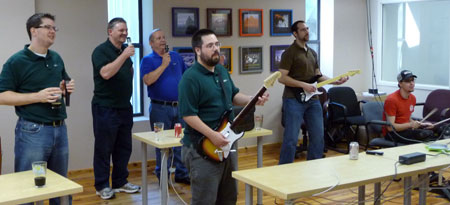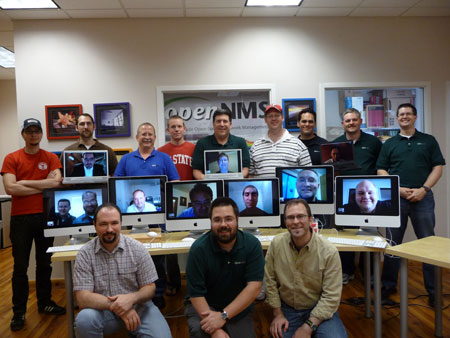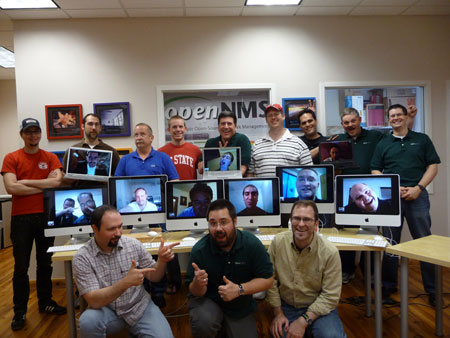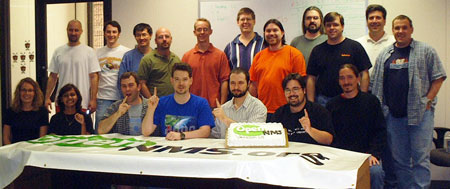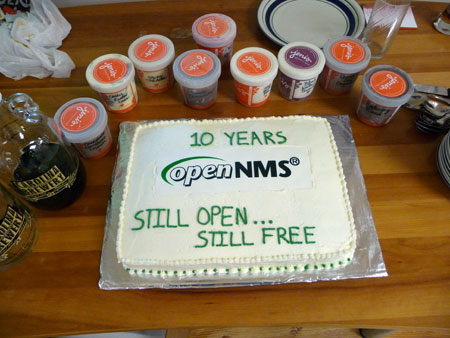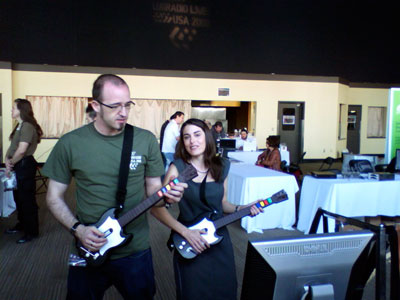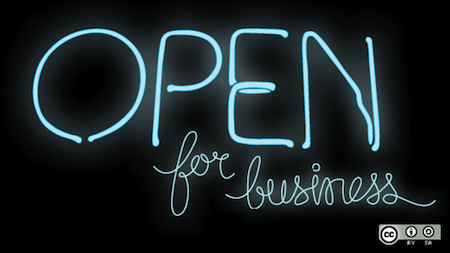I am currently in San Francisco attending the Open Source Business Conference (OSBC). While the conference has been around for awhile, I have never had a desire to attend before since people have told me it is more like the Open Core Business Conference. Also, it was founded my Matt Asay who nurses a strong dislike for OpenNMS (for proof just check out his negative article on us and our BOSSIE last year which is based on quotes that don’t seem to exist in the original article).
We have a standing rule at the OpenNMS Group that we will pay the expenses for any employee who gets a paper accepted at a conference, so I dutifully submitted two talks. The first was my ever evolving “So You Think You Want to Start and Open Source Business?” presentation, but since I was pretty certain that would be shot down, I also suggested another presentation where two of our “Ultra” support customers, Rackspace and New Edge, could talk about how they use the OpenNMS management application platform in their business.
Both were shot down.
In any case, the number of open source shows is small and the number of people I wanted to meet that were attending this one was large, so I decided to come anyway. Here are my thoughts on day one.
As someone who runs an open source business, I figured that the conference would be aimed at people like me. Instead, looking at the agenda the conference should be renamed the Open Source in Business Conference since, this year at least, it is much more about using open source than basing a company on it.
The first keynote was delivered by Jim Whitehurst, CEO of Red Hat. I am an unabashed fan boy of Red Hat, and now it seems I have a slight man crush on Jim.
This was the first time I had seen him in person. I met his predecessor, Matt Szulik, on a number of occasions, and Szulik always struck me as the somber corporate type. Jim, on the other hand, reminds me more of the people I usually meet in open source. He’s very energetic and more importantly, he gets it. Even though he came from Delta Airlines, an industry very different from open source software, he demonstrates a strong understanding of the value it provides.
He doesn’t sell on price, but power. Open source is not about saving money but it is about innovation. His customers have a lot of innovation to do within their own businesses, and open source is the best way to get that done. Of course price is a factor, but it isn’t the main one.
He did point out that Red Hat is the largest “pure-play” open source company. I hate the fact that he even had to say “pure-play,” but there are people that want to blur the definition of an open source company to include the likes of Google and Microsoft, so I was happy he went out of his way to mention it.
He also touched on a theme that I would see throughout the day. It’s this idea of applying open source development concepts to other issues. He ended the talk with a discussion of the new opensource.com site which exists not only to discuss open source software but to apply the “power of participation” to solving other problems.
He won me over by not simply reading a list of Powerpoint bullets off the screen. His slides were images and phrases that complimented the talk but weren’t the center of it. I was impressed.
This was followed by a panel discussion that included Tim Yeaton (CEO of Black Duck), Larry Augustin (The Dark Lord of Open Source), Dries Buytaert (Founder of Drupal) and Jim Whitehurst. It was moderated by Michael Skok of North Bridge Venture Partners, a venture capital firm, and since VCs are the driving force behind open core business models I figured this is where I would start to get my hackles up.
I was wrong.
I hate panel discussions, but this one was pretty good. They reviewed a survey that was sent out that explored various aspects of open source adoption, and they compared it to previous years.
Jim won me over again when, on one slide discussing open source business models, there was quite a difference between it and the year before (and that slide was different than the year before it). He said that this “moving of the bars” represented that people were still experimenting with the best ways to make money on open source and this was a good thing. At OpenNMS our business plan changes quite frequently as we continually tune our offerings to our customer needs, so I agreed with him.
Larry even impressed me when he stated that he hates to compete on price. OpenNMS is not the cheapest solution for everyone, but it is the best solution for many large enterprises and carriers based on power, flexibility, scalability and, yes, total cost of ownership. But if one expects a bargain basement solution they will be disappointed.
Then he lost me when he confused dual licensing with open core licensing. Dual Licensing is when 100% of the code is available under both an open source license and a proprietary one (like our Powered By OpenNMS program) whereas Open Core licensing is where some of the code is open but a good portion of it is not.
One reason I hate panel discussions is that it is hard for the audience to get involved. At one point Dries pointed out that there are over 5000 plugins for Drupal. I think that’s great, but I wanted to ask what is the difference between an open source project and its plugins versus a closed source project with an open API and its plugins (like Facebook). Plugins alone can’t be the reason to choose a solution.
The next to the last slide discussed “cool” open source projects, in that new fancy way where the word with the most attention is larger than the surrounding words (I need to know the technical name for this, so if anyone knows it, drop me a note or comment). Drupal was very large and it was interesting to see Nagios up there, too. OpenNMS was represented, but in the smallest font. I should point out that Apache and Thunderbird were the same font size as us, so I’m not too disappointed.
The last question was phrased “What Percent of Purchased Software Will Be Open in the Next 5 Years?” I thought it was silly to talk about “purchasing” open source software. It still shows the open core mentality that software has to be purchased. Sure, they could mean services purchased around open source software, but it wasn’t phrased that way. Open source is so much more about building an innovative solution than software licenses that I wish they would have recognized that in their question.
The next keynote was delivered by Bob Sutor of IBM. He started off with a disclaimer where the words “ideology” and “philosophy” were surrounded by one of those red “not” circles with the bar across it. Anytime someone tells me I need to ignore open source ideology and philosophy usually means they are about to try to redefine them. My guard was up.
It didn’t need to be. His talk, despite being Powerpoint bullet lists, was good. He pointed out that as a percentage of overall software used, open source is still pretty small. He touched a painful point with our project when he mentioned that the quality of documentation is often a reflection on the quality of the software. I don’t agree with it fully but there is a nugget of truth to it. He then took a stab at the open core crowd by differentiating between open source and “coding in public”.
It was interesting to contrast him with Jim Whitehurst. He definitely has more of a corporate demeanor and a wicked talent for talking about other companies without naming them. He also talked about how companies that modify open source in house should contribute back to the community since the cost of propagating changes to the code over time erodes the value of using it.
He didn’t need the disclaimer.
That was the end of the morning keynotes. My first breakout session was Matt Aslett’s talk on The Evolution of Open Source Business Strategies.
Matt was one of the people I came to the conference to meet, and I enjoyed his talk. He works for the 451 Group which published a report in 2008 entitled “Open Source is Not a Business Model“.
They took a lot of heat from the open source community as the word “not” was perceived as a knock against open source in general. It reminded me of Leonard Nimoy’s book “I Am Not Spock” which got him labeled as a Star Trek hater. Never use the word “not” in a title if you can help it.
At OpenNMS our mission is to help customers, have fun doing it, and make money. Our business model is based on services, and open source is simply a strategy. In his talk he discusses a number of open source strategies, from pure play companies like ours up through open core and the obligatory “cloud” reference.
He did stress the difference between dual licensing and open core, and he used OpenNMS as a case study for both a pure open source services company and dual licensing. It was a good talk and nice to finally meet him in person.
I met a number of other cool people. Jay Lyman, who also works for the 451 Group, is giving a talk on Thursday. I stopped by the Microsoft booth to chat with Brenton Phillips to thank him for our MSDN subscription. We had a nice talk about the difference between open source companies and those that use open source.
Next to their booth was the Red Hat booth. Jason Hibbets was there representing opensource.com. I also met Daniel Chalef, the CEO of KnowledgeTree which is based out of Raleigh as well.
I got introduced to an open source document management company called Nuxeo. It is a pure-play open source company based out of France (the French don’t have any trouble differentiating between open source and open core). I met Cheryl McKinnon, their Chief Marketing Officer, and I need to check out their project (us pure play folks need to stick together).
The final keynote of the day was a presentation by Tim O’Reilly. This is the second time I have seen him speak (the first was as OSCON a few years ago). Tim is so far ahead of the curve it takes me awhile to digest what he says. My initial instinct is often to disagree with him, but then I realize that he tends to be talking about something much different than what I think he is talking about.
This lack of comprehension could be a weakness on my part, but since the first audience question was “hey, could you connect the dots for me?” I wasn’t the only one. Despite that, he is an engaging speaker.
His talk was basically how low cost “sensor” hardware (such as smartphones and other devices) are going to feed raw data up to large, centralized databases (the cloud) where the web will enable us to access rich content applications. He talked about a weight scale he owns that is wi-fi enabled so he can track his weight (about 181 pounds, if you care), as well as a device from Phillips that measures his daily activity.
Then he showed a somewhat darker side of all this data. There is a project in the UK called AMEE that collects energy use data in order to calculate carbon footprints. They have a number of sensors that measure, say, electricity consumption, and it is sensitive enough that they can pinpoint not only when a particular appliance was used, such as a dishwasher, but also the make and model of the appliance. While AMEE’s motives seem benign, it demonstrated how this data can pose a serious threat to privacy (and I should note that their raw data is openly available).
Tim focused on the rise of such databases, and how the bigger the database, the better it works. The owners of this data (such as Google and Facebook) are thus in a pretty powerful position. It severely limits the ability for others to enter the market, and easy entry and exit is a cornerstone of functioning markets.
But I was having a problem understanding how the call for “open data” related to open source. I think open data is one of the more pressing technology issues facing our society today, but I couldn’t see how that was relevant to my business.
Tim kind of brought it together with the concept that these growing data sinks, such as Google, are becoming impossible to compete with. Google has a business advantage to keeping the data closed. With Google having something like 10 million servers, it would take a huge investment just to get started, and a traditional competition model fails.
Thus the only way to prevent putting the best databases in the hands of a few corporations is to adopt an open source attitude. He demonstrated this by searching for the Palace Hotel (the site of the conference) on a number of open source sites, such as OpenStreetMap. He couldn’t find it. However, a site like Yelp has a lot of information on the hotel. Wouldn’t it be nice if Yelp was able to share its location database with OpenStreetMap? Not all of its data, of course. Yelp would keep the reviews, etc., but OpenStreetMap could reciprocate by linking searches back to Yelp.
This idea of reciprocity is core to the open source philosophy, and it is probably the only option available to bring any sort of openness and competition to the data market.
His talk made me think, which is always a good thing.
Speaking of good things, I was pretty happy with the first day of the conference. There was little in the way of people trying to redefine “open source” and a lot of focus on the value that it brings. That doesn’t mean I trust or agree with everyone who spoke, but I was surprised at how the conference didn’t try to hit me over the head with the idea that the only way to be successful in an open source business is to sell software. On a side note, this week our corporate taxes were due and I’m willing to bet I paid more in taxes than most of these VC-backed open core companies made in profits last year.
The day ended with a cocktail reception. As a final note, if you ever attend a conference in California with an open bar, offer to tip your server. While they can’t display a “tip jar” they are allowed to accept tips, and in the spirit of reciprocity a nice tip will get you extra good service. Since it was St. Patrick’s Day, a little Jameson and ginger ale was in order. (grin)
